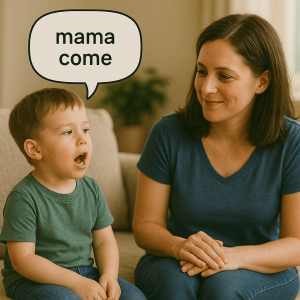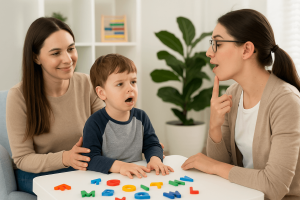Top L Words for Effective Speech Therapy
Last Updated: September 3, 2024
Speech therapy plays a vital role in helping children overcome challenges with specific sounds, and one common difficulty is the pronunciation of the L sound. If your child struggles with saying words like “lion” or “leaf,” you’re not alone. Many children find the L sound tricky due to its unique tongue placement and articulation. But with the right guidance and consistent practice, mastering the L sound becomes much more attainable.
Focusing on L words during speech therapy can significantly improve both pronunciation and communication skills. By emphasizing these sounds, children can develop clearer speech, which boosts their confidence and enhances their ability to express themselves. Whether you’re a parent supporting your child speech development or a therapist seeking effective techniques, understanding the importance of L words in therapy is key to making progress.
Worried About Your Child’s Speech Development? Get Expert Guidance – For Free!
Understanding the L Sound in Speech Therapy
The L sound is one of those tricky sounds that many children struggle to master. But why is it so challenging? The answer lies in the specific mechanics required to produce this sound correctly. For the L sound, proper tongue placement is key. Unlike other sounds, where the tongue may rest lower in the mouth, the L sound requires the tongue to rise and press against the roof of the mouth, just behind the upper teeth. This positioning can be difficult for some children to achieve, especially when they’re still developing control over their tongue movements.
Another common issue is airflow. When producing the L sound, the tongue should create a small gap at the sides, allowing air to flow out smoothly. However, if the tongue placement is off, it can block the airflow, resulting in a distorted or incorrect sound. These subtle yet crucial details make the L sound a common stumbling block in speech development.
Understanding these challenges is the first step in helping children overcome them. By focusing on correct tongue placement and smooth airflow, speech therapy can guide children toward clearer and more confident pronunciation. As you work through the strategies and activities designed to address these issues, you’ll notice significant improvements in your child’s ability to articulate the L sound, making everyday communication much more effective.
Also read: Pro Tips for Effective Tongue Exercises in Speech Therapy
Benefits of L Words Speech Therapy
When children participate in L words speech therapy, the positive outcomes extend beyond just improving a single sound. Here’s how focusing on the L sound can make a significant difference in your child’s speech development:
1. Improve Articulation of the L Sound
The primary goal of L words speech therapy is to help children correctly articulate the L sound. By focusing on specific words and activities, children learn how to position their tongues and manage airflow, resulting in clearer and more accurate pronunciation of the L sound. This improvement lays a strong foundation for their overall speech development.
2. Enhance Overall Speech Clarity and Communication
Mastering the L sound doesn’t just impact individual words—it enhances the clarity of your child’s entire speech. As they become more confident in producing the L sound, their overall communication improves, making it easier for others to understand them. Clear speech is key to effective communication, whether at home, in school, or in social settings.
3. Boost Confidence in Children as They Master the L Sound
There’s nothing quite like the confidence boost that comes from overcoming a challenge. As children progress in L words speech therapy, they gain a sense of accomplishment, knowing they can now pronounce words that were once difficult. This newfound confidence often translates into more willingness to speak up and engage in conversations.
4. Encourage Better Social Interactions Due to Improved Speech
Clear and confident speech opens doors to better social interactions. When children can articulate the L sound correctly, they feel more comfortable participating in group activities, making friends, and expressing their thoughts. Improved speech reduces the frustration that often accompanies miscommunication, leading to more positive social experiences.
Top L Words Speech Therapy Activities for Kids
To help children master the L sound, incorporating a variety of engaging and effective activities is key. Here are some of the top L words speech therapy activities that can make a real difference in your child’s progress:
1. Visual and Auditory Cues
Using visual and auditory cues can greatly enhance a child’s ability to produce the L sound correctly. For instance, a mirror allows children to see the proper tongue placement, helping them adjust their positioning as they practice. Additionally, sound recordings of the correct L sound give children an auditory reference, enabling them to match what they hear with what they say. Combining these visual and auditory elements creates a more holistic learning experience, making it easier for children to understand and replicate the sound.
2. Syllable Practice
Breaking down L words into syllables is an effective way to help children focus on the sound in smaller, manageable parts. For example, practicing the syllables “la,” “lo,” and “le” separately before combining them into full words like “ladder,” “local,” or “lemon” allows children to master the L sound incrementally. This step-by-step approach builds their confidence and helps solidify the correct articulation of the L sound in various word positions.
Also Read: 6 Effective Speech Therapy Games for Young Children
3. Minimal Pairs Practice
Minimal pairs practice involves using pairs of words that differ only by the L sound, such as “lip” and “tip” or “lag” and “tag.” This method helps children distinguish between the correct and incorrect sounds, sharpening their ability to hear and produce the L sound accurately. By focusing on these subtle differences, children can better understand the importance of correct articulation and apply it across different contexts.
| Minimal Pair | Example Words | Purpose |
|---|---|---|
| Initial L | Lip vs. Tip | Helps distinguish between L and T sounds at the beginning of words. |
| Medial L | Pillow vs. Pitter | Focuses on the L sound in the middle of words to improve clarity. |
| Final L | Ball vs. Bat | Ensures correct pronunciation of the L sound at the end of words. |
4. Storytelling and Reading
Incorporating L words into storytelling and reading sessions is a fun and engaging way to practice the sound. Whether you’re reading a book filled with L words or encouraging your child to create their own story using these words, this activity makes learning feel less like work and more like play. It also provides context, helping children understand how the L sound fits naturally into everyday language.
5. Games and Activities
Games are a great way to keep children motivated during speech therapy. Consider activities like word bingo, where each square features an L word, or scavenger hunts where children must find objects that start with the L sound. These interactive games make practicing the L sound enjoyable, ensuring that children stay engaged and enthusiastic about their progress.
6. Articulation Drills
Repetition is key in mastering the L sound, and articulation drills provide the necessary practice. These drills involve repeating L words in various positions within words—beginning, middle, and end. For example, practicing “light,” “balloon,” and “tall” in a structured drill helps reinforce the correct sound in different contexts. Over time, this repetition strengthens muscle memory, making the L sound more natural for your child to produce.
Tips for Parents and Therapists
Supporting a child through L words speech therapy requires a thoughtful approach. Here are some essential tips for parents and therapists to ensure effective and enjoyable progress:
1. Consistency is Key
When it comes to mastering the L sound, regular practice is crucial. Encourage your child to practice L words not just during therapy sessions but also at home. Consistent repetition helps reinforce the correct tongue placement and articulation, making it easier for the child to produce the sound naturally. Whether it’s a quick practice session during breakfast or a few minutes before bedtime, consistency will make a significant difference in your child’s progress.
2. Positive Reinforcement
Children respond well to encouragement, and positive reinforcement can be a powerful motivator. Celebrate small victories by offering praise, stickers, or other rewards when your child correctly pronounces L words. Positive reinforcement builds confidence and keeps children motivated to continue practicing, even when the sound feels challenging. Remember, a little encouragement can go a long way in helping your child feel proud of their achievements.
3. Involve the Child
To keep therapy sessions engaging, involve your child in choosing the L words and activities they enjoy. When children have a say in the process, they’re more likely to be enthusiastic about participating. Whether it’s selecting favorite L words for practice or picking a fun game that incorporates these words, involving the child ensures that therapy feels less like a chore and more like a collaborative effort.
4. Patience and Progress Tracking
Progress in speech therapy doesn’t happen overnight, so patience is essential. Some children may master the L sound quickly, while others may take a bit longer. Track your child’s progress by noting improvements, even if they seem small. Over time, these incremental gains add up to significant strides. Keeping a positive attitude and focusing on the progress made, rather than the remaining challenges, helps maintain momentum and motivation.
Common Challenges and Solutions
Even with the best intentions, children can face several challenges while learning to master the L sound in speech therapy. Understanding these common hurdles and knowing how to address them can make the journey smoother for both parents and therapists.
1. Difficulty in Isolating the L Sound
One of the most frequent challenges children face is isolating the L sound from other sounds. This can occur when the L sound blends with surrounding vowels or consonants, making it harder for children to produce it clearly. To help children isolate the L sound, it’s beneficial to start with simple exercises that focus solely on the L sound itself. For instance, practicing the L sound in isolation by saying “luh” or “lah” repeatedly can help children become more familiar with the correct tongue placement and airflow. Once they are comfortable with this, gradually introduce simple L words, paying close attention to how the sound is produced within those words.
2. Inconsistency in Pronunciation
Another challenge is inconsistency in pronunciation, where a child may correctly pronounce the L sound in some words but struggle with others. This inconsistency can be frustrating for both the child and those helping them. To address this, consistency in practice is key. Using minimal pairs—words that differ only by the L sound, like “lip” and “tip”—can help reinforce the correct pronunciation. Additionally, breaking down words into syllables and practicing them slowly can build the muscle memory needed for consistent pronunciation across different contexts.
3. Lack of Motivation
Keeping children motivated during L word practice can sometimes be a challenge, especially if they find the exercises repetitive or difficult. To overcome this, it’s important to make practice sessions as engaging and enjoyable as possible. Incorporating games, interactive activities, and allowing the child to choose some of the L words they want to work on can make a big difference. Positive reinforcement, such as praise or small rewards for progress, also helps sustain their interest and encourages them to keep practicing.
Conclusion
Improving the L sound is a journey that takes time, patience, and a mix of fun activities. By using tools like mirrors, practicing syllables, reading stories, playing games, and doing repetition drills, children can gradually get better at pronouncing the L sound. These different activities keep learning interesting and help make progress steady and noticeable.
Parents and therapists are key to this progress. Staying consistent, offering praise, and keeping practice sessions engaging are all important in helping children succeed. Progress might come slowly, but every small achievement is a step forward. If you need more help or ideas, Wellness Hub has plenty of resources to guide you through the process and support your child’s speech development journey.
Frequently Asked Questions:
1. What are the best activities for teaching the L sound in speech therapy?
The best activities include using visual and auditory cues, practicing syllables, engaging in storytelling, playing interactive games, and doing articulation drills. These varied approaches help children improve their L sound in a fun and effective way.
2. Why is the L sound difficult for some children to pronounce?
The L sound can be challenging because it requires specific tongue placement and airflow. Children may struggle with these mechanics, making it hard to isolate and produce the sound clearly.
3. How can I help my child practice the L sound at home?
You can help by encouraging regular practice, using mirrors for visual feedback, playing games that focus on L words, and reading books that include L sounds. Consistency and positive reinforcement are key.
4. What should I do if my child pronounces the L sound inconsistently?
If your child is inconsistent with the L sound, try using minimal pairs (words that differ only by the L sound) and breaking words down into syllables. Regular practice will help build consistency over time.
5. How do I keep my child motivated during L word practice?
Keeping practice sessions fun and interactive is important. Involve your child in choosing the words and activities they enjoy, and use positive reinforcement to encourage their efforts.
6. What are common challenges in learning the L sound, and how can they be overcome?
Common challenges include difficulty isolating the L sound, inconsistent pronunciation, and lack of motivation. These can be overcome with targeted techniques, consistent practice, and engaging activities that make learning enjoyable.
7. How long does it take for a child to master the L sound?
The time it takes varies for each child. With regular practice and support from parents and therapists, most children show improvement over a few weeks to months.
8. Where can I find more resources on L words speech therapy?
For more guidance and resources on speech therapy, including tips for improving the L sound, you can visit Wellness Hub’s website, where a range of helpful materials are available.
9. Can speech therapy help my child with other sounds besides the L sound?
Yes, speech therapy is designed to help with various sounds and speech challenges. While this article focuses on the L sound, similar techniques can be applied to other difficult sounds, helping your child improve overall speech clarity and communication.
10. How can I tell if my child needs speech therapy for the L sound?
If your child consistently struggles to pronounce the L sound or substitutes it with other sounds (like saying “wabbit” instead of “rabbit”), it may be time to consult a speech therapist. Early intervention can make a big difference in your child’s speech development.
About the Author:
Anuradha Karanam
Speech-language pathologist (7+ years of experience)
Anuradha Karanam is a skilled speech-language pathologist with over 6 years of experience. Fluent in Tamil, Telugu, Hindi, and English, she specializes in parent counseling, speech sound disorders, fluency assessment, and speech-language evaluations. Anuradha excels at working with children with developmental disorders, offering creative and effective therapy programs. Currently, at Wellness Hub, she holds a BASLP degree and is registered with the RCI (CRR No A85500). Her patience, ambition, and dedication make her a trusted expert in her field.
Book your Free Consultation Today
Parent/Caregiver Info:
Client’s Details:
* Error Message








